Instruction for use: Rheogluman
I want this, give me price
Dosage form: Solution for infusions
Active substance: Dextranum 30000-40000+Mannitolum+Natrii chloridum
ATX
B05AA05 Dextran
Pharmacological group
Substitutes for plasma and other blood components
The nosological classification (ICD-10)
A39 Meningococcal infection: Asymptomatic carriage of meningococci; Infection of meningococcal; Meningococcus aureus; The epidemic of meningitis
I73.0 Raynaud's Syndrome: Raynaud's syndrome Leriche; Raynaud's disease; Raynaud's phenomenon; RaynaudLeriche syndrome; Raynaud's disease; Raynaud's syndrome with trophic disorders; Peripheral angiopathy
I73.1 thromboangiitis obliterans [Buerger's disease]: Berger's disease; thromboangiitis obliterans; trombangiit; thromboangiitis obliterans; Buerger's disease
I74 Embolism and arterial thrombosis: Thrombosis of effort (stress); Arterial thrombosis; Arteriothrombosis; Subacute and chronic arterial thrombosis; Subacute thrombosis of peripheral arteries; Postoperative thrombosis; Vascular thrombosis; Vascular embolism; Thrombosis of aortocoronary shunt; Arterial thrombosis; Thrombosis of arteries; Coronary artery thrombosis; Coronary thrombosis; Thrombosis of blood vessels; Thrombosis with ischemic stroke; Thrombosis with general surgical operations; Thrombosis in Oncology Operations; Vascular thrombosis; Thrombus formation in the postoperative period; Thrombotic complications; Thromboembolic diseases; Thromboembolic syndrome; Thromboembolic complication in the postoperative period; Thromboembolism of arteries; Partial vascular thrombosis; Embolism; Embolism of arteries
I77.6 Unspecified Arteritis: aortoarteriit; vasculitis; Neateroskleroticheskoe coronary arteries
I80 Phlebitis and thrombophlebitis: Diseases of peripheral vessels; Inflammation of superficial veins; Inflammatory diseases of veins; Deep venous thrombophlebitis; The disease of veins; Disease of the veins of the lower extremities; Diseases of peripheral vessels; Migrating phlebitis; Insufficiency of veins of lower extremities; Exacerbation of chronic thrombophlebitis; Acute thrombophlebitis; Acute thrombophlebitis of superficial veins; Periphlebitis; Periflebit surface; Superficial inflammation of veins; Surface thrombophlebitis; Surface phlebitis; Thrombophlebitis; Deep vein thrombophlebitis; Thrombophlebitis superficial; Phlebitis; Phlebitis of deep veins; Phlebitis of superficial veins; Phlebopathy; Chronic thrombophlebitis; Endophlebitis
K65 Peritonitis: Abdominal infection; Intra-abdominal infections; intra-abdominal infections; Diffuse peritonitis; abdominal Infections; Infections of the abdominal cavity; The infection of the abdominal cavity; The infection of the gastrointestinal tract; Spontaneous bacterial peritonitis
K72 Hepatic insufficiency, not elsewhere classified (including hepatic coma): Liver cell insufficiency; Pronounced hepatic encephalopathy; Coma hepatic; Latent hepatic encephalopathy; Insufficiency of the liver; Hepatic coma; Hepatic coma and precoma; Hepatic encephalopathy; Development of hepatic impairment; Encephalopathy of the liver; Inflammatory liver disease; Gepatargy; Encephalopathy portosystemic; Hepatocellular insufficiency; Hepatic precoma and coma; Portal-systemic encephalopathy
K85 Acute pancreatitis: Acute pancreatitis; Pancreatitis; Pancreatitis haemorrhagic; acute Pancreatitis; Sepsis pancreatogenic; Acute necrotizing pancreatitis; edematous pancreatitis
N19 Renal failure, unspecified: Hyperazotemia; Uremia; Kidney failure in poisoning
R57 Shock, not elsewhere classified: Obstructive shock
R57.0 Cardiogenic shock: Cardiogenic shock
R57.8 Other shock: shock transfusion; obstructive shock; circulatory shock
R57.8.0 * Burn shock: Pain shock for burns; Burn shock
T30 Thermal and chemical burns of unspecified site: Pain syndrome with burns; Pain in burns; Pain with burns; Sluggishly healing post-burn wounds; Deep burns with a wet scab; Deep burns with abundant compartments; Deep burn; Laser burn; Burn; Burn of rectum and perineum; Burn with mild exudation; Burn disease; Burn injury; Superficial burn; Superficial burn of I and II degree; Superficial skin burns; After-burn trophic ulcer and wound; Post-burn complication; Loss of fluid in burns; Sepsis burn; Thermal burns; Thermal skin lesions; Thermal burn; Trophic after-burn ulcers; Chemical burn; Surgical burn
T79.4 Traumatic shock: Haemorrhagic shock; Crash Syndrome; Posthemorrhagic shock; Postoperative shock; Post-traumatic shock; Post-traumatic shock; Traumatic shock; Syndrome of hemorrhagic shock and encephalopathy
T80 Complications associated with infusion, transfusion and medical injection: Post-transfusion complication; Transfusion hemolytic reaction
T81.1 Shock during or after the procedure, not elsewhere classified: Operating shock; Postoperative shock; Operational shock
Z100 * CLASS XXII Surgical practice: Abdominal surgery; adenomectomy; Amputation; Coronary angioplasty; Angioplasty of the carotid arteries; Antiseptic skin treatment for wounds; Antiseptic Hand; Appendectomy; atherectomy; Balloon coronary angioplasty; Vaginal hysterectomy; The coronary bypass; Interventions in the vagina and cervix; Interventions on the bladder; Intervention in the mouth; Restoration and reconstructive surgery; Hand hygiene of medical personnel; Gynecologic surgery; Gynecological intervention; Gynecological surgery; Hypovolemic shock during operations; Disinfection of purulent wounds; Disinfection of wounds edges; Diagnostic intervention; Diagnostic procedures; Cervical Diathermocoagulation; Long-surgery; Replacing the fistula catheters; Infection in orthopedic surgery; Artificial heart valve; cystectomy; Short-term outpatient surgery; Short-term operation; Short surgical procedures; Krikotireotomiya; Blood loss during surgery; Bleeding during surgery and in the postoperative period; Kuldotsentez; laser photocoagulation; laser coagulation; retinal laser coagulation; Laparoscopy; Laparoscopy in Gynecology; CSF fistula; Small gynecological operations; Small surgical procedures; Mastectomy and subsequent plastic; mediastinotomy; Microsurgical operations on the ear; Mukogingivalnye operation; suturing; Minor surgery; neurosurgical operation; Immobilization of the eyeball in ophthalmic surgery; testectomy; pancreatectomy; Perikardektomiya; The period of rehabilitation after surgery; The period of convalescence after surgery; Percutaneous transluminal coronary angioplasty; Pleural thoracentesis; Pneumonia postoperative and posttraumatic; Preparation for surgical procedures; Preparation for surgery; Preparation of the surgeon's hands before surgery; Preparation of the colon for surgical procedures; Postoperative aspiration pneumonia in neurosurgical and thoracic surgery; Postoperative nausea; Postoperative bleeding; postoperative granuloma; postoperative shock; The early postoperative period; myocardial revascularization; Radiectomy; gastric Resection; bowel resection; uterine Resection; liver Resection; enterectomy; Resection of part of the stomach; Reocclusion of the operated vessel; Bonding tissues during surgical procedures; Removal of sutures; Condition after eye surgery; Condition after surgery; Condition after surgery in the nasal cavity; Condition after gastrectomy; Status after resection of the small intestine; Condition after tonsillectomy; Condition after removal of the duodenum; Condition after phlebectomy; Vascular surgery; Splenectomy; Sterilization of surgical instruments; Sterilization of surgical instruments; sternotomy; Dental surgery; Dental intervention in periodontal tissues; strumectomy; Tonsillectomy; Thoracic surgery; Thoracic surgery; total gastrectomy; Transdermal intravascular coronary angioplasty; Transurethral resection; Turbinektomiya; Removal of a tooth; cataract surgery; Removal of cysts; tonsillectomy; Removal of fibroids; Removing the mobile primary teeth; Removing polyps; Removing broken tooth; Removal of the uterus body; Removal of sutures; Fistula likvoroprovodyaschih ways; Frontoetmoidogaymorotomiya; Surgical infection; Surgical treatment of chronic limb ulcers; Surgery; The surgery in the anal area; The surgery on the colon; Surgical practice; The surgical procedure; Surgical interventions; Surgery on the gastrointestinal tract; Surgical procedures on the urinary tract; Surgical procedures on the urinary system; Surgical intervention of the genitourinary system; Surgical procedures on the heart; Surgical manipulation; surgery; Surgery on the veins; Surgical intervention; Vascular surgery; Surgical treatment of thrombosis; Surgery; cholecystectomy; Partial gastric resection; hysterectomy; Percutaneous transluminal coronary angioplasty; Percutaneous transluminal angioplasty; Coronary artery bypass; tooth Extirpation; Extirpation of milk teeth; pulpectomy; pulsative cardiopulmonary bypass; tooth Extraction; teeth Extraction; cataract extraction; Electrocoagulation; endourological intervention; episiotomy; Etmoidotomiya; Complications after tooth extraction
Composition and release form
Solution for infusion - 100 mlDextran with a molecular weight of 30,000 to 50,000 10 g
Mannitol 5 g
Sodium chloride 0.9 g
Water for injection to 100 ml
In bottles of 400 ml, in a box of 1 or 15 bottles.
Description of dosage form
Transparent colorless or slightly yellowish liquid, odorless.
Characteristic
Plasma-substituting polyfunctional blood substitute based on low molecular weight dextran, pH 4.0-6.5; Relative viscosity at 25 ° C is not more than 7.0; Theoretical osmolarity 310 mOsm / l.
Pharmachologic effect
Mode of action - Antiaggregational, plasma-substituting, improving microcirculation.
Reduces the viscosity of the blood due to anti-aggregation effect on the blood elements, promotes the restoration of blood flow in small capillaries, improves hemodynamics. It also has anti-shock, detoxification and osmodiuretic effect.
Each gram of dextran, which is part of the drug, facilitates the transfer of 20-25 ml of fluid from the tissue into the bloodstream.
Pharmacokinetics
The drug is excreted from the body, mainly through the kidneys: for the first day - about 70%. The rest of the drug enters the reticuloendothelial system, where it gradually dissolves to glucose.
Indications of the drug Rheogluman
It is used to improve capillary blood flow in order to prevent and treat diseases accompanied by a violation of microcirculation, both local and general, combined with fluid retention in the body: violation of capillary blood flow (traumatic, burn, toxic, cardiogenic shock); Violation of arterial and venous circulation (thrombosis, thrombophlebitis, endarteritis, Raynaud's disease); Vascular and plastic surgery (to improve local circulation and reduce the tendency to thrombosis in the transplant); Renal and renal-hepatic insufficiency with preserved filtration function of the kidneys; Posttransfusion complications caused by transfusion of incompatible blood; For detoxification with burns, injuries, peritonitis, pancreatitis.
Contraindications
Excessive hemodilution (hematocrit below 25%), hemorrhagic diathesis, circulatory insufficiency with pronounced edema, severe renal failure accompanied by anuria, significant dehydration, severe allergic states of unclear etiology.
Side effects
After the transfusion of Reogluman, adverse reactions are usually not observed.
In some previously sensitized patients, allergic reactions of varying severity may occur. It should be borne in mind the possibility of anaphylactic shock in patients at risk who have a history of intolerance to intravenous infusions of protein preparations, plasma substitutes, including dextran preparations, as well as serums and vaccines. In case of allergic reactions or anaphylactic shock, immediately stop the infusion and, without removing the needles from the vein, introduce symptomatic drugs used in the therapy of anaphylactic shock (antihistamines, cardiac, vasopressor drugs, corticosteroids, etc.).
Possible development of tachycardia, lowering blood pressure.
Interaction
Compatible with other preparations of dextran (Polyglukin, Reopoliglyukin) and crystalloid solutions.
Dosing and Administration
IV, by drop infusion. The dose and rate of administration should be selected individually in accordance with the indications, assessment of the patient's condition, his hourly and daily diuresis.
In complex therapy of shock in case of capillary blood flow disturbance, the drug is injected intravenously at a dose of 400 to 800 ml, under the control of hemodynamic parameters (BP, central venous pressure, volume of blood circulation, hourly and diuresis daily).
In case of burn shock, a 2-3-fold administration of the drug within the first 24 hours from the moment of injury is permissible. The first dose - 400 ml - can be administered drip for 2 hours, the second - after 6-12 hours with the same infusion rate. If other dextran preparations are used in case of burn shock (Polyglukin, Reopoliglyukin), their total dose should not exceed 1600 ml / day (100-130 g of dextran). During the second day of the shock period, with stabilization of bcc, blood pressure and diuretic, Reogluman administered 400 mg 1-2 times. In the period of acute burn toxemia, 400 ml per day can be applied intravenously every 4 hours in the infusion therapy with mandatory control of daily diuresis, hemoglobin and hematocrit. During septicotoxemia, the use of Reogluman in the same doses is most useful when preparing a patient for autodermoplasty and for the first 2 days from the moment of its implementation.
In cardiovascular and plastic surgery, they are administered immediately before the operation (30-60 min) at a dose of 10 ml / kg, during the operation 400 ml and after the operation every day for 5-6 days IV by drop infusion, at a rate of 10 ml / Kg per single administration.
In acute renal and hepatic insufficiency with preserved filtration and with post-transfusion complications, single dose 400-800 ml is administered. The infusion can be repeated daily for 3-5 days, at a rate of 10 ml / kg for administration, under the control of the water-electrolyte and acid-base balance, the coagulating blood system.
Precautionary measures
Jet injection can lead to hypervolemia due to the expressed colloid-osmotic effect of the drug.
Special instructions
Before the transfusion, the doctor must perform a visual examination of the drug and record the results in the medical history. The preparation should be transparent, free from suspensions, there should be no cracks or seals on the bottle.
When using Rheogluman, a biological test is mandatory: after a slow injection of the first 5 drops, the infusion is stopped for 3 minutes, then another 30 drops are added and then stopped for 3 minutes. In the absence of the reaction, the administration is continued at a rate of 40 cap / min. An increase in the rate of administration of more than 40 cap / min is possible only with a dynamic observation of central venous pressure and ECG.
To maintain the water and electrolyte balance, together with Rheogluman, it is advisable to introduce solutions containing potassium and sodium.
Manufacturer
JSC "Biochimik", Russia.
Storage conditions of the drug Rheogluman
In a dry place at a temperature no higher than 25 ° C. During transport, freezing up to 10 ° C is allowed.
Keep out of the reach of children.
The shelf life of the drug Rheogluman
3 years.
Do not use beyond the expiration date printed on the package.

 Cart
Cart





